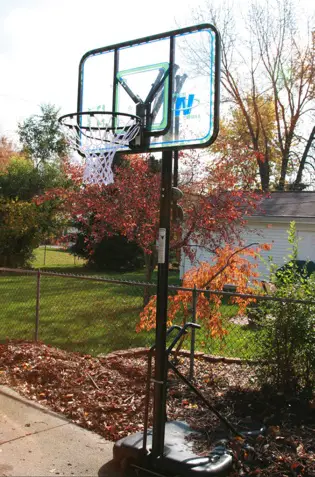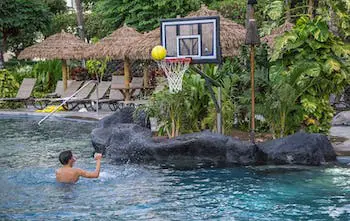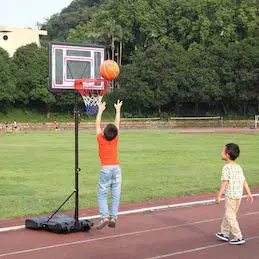The hoop is by far the most iconic piece of basketball equipment. If you’re ever looking to play, just start shooting on one and sooner or later, someone will join you. Before you know it, you have a 3 on 3 or a 5 on 5 going.
Your Guide
 Edis Hajlovac
Edis Hajlovac
Finding a hoop to play on is much easier than picking one out for yourself.
You may have already decided to buy your own hoop so you don’t have to rely on any outdoor or indoor courts when you want to get some practice in.
Our Top Pick:
If so, you may have seen that there are way more options out there than you were probably expecting.
This abundance of choice can easily overwhelm us when we are trying to make any decision, whether it is buying a basketball hoop or picking out a new brand of cereal when your favorite is out of stock.
We’ll try to bring some order into the chaos that an abundance of choice can create, so we have divided this guide on picking the best basketball hoop into several categories that are first going to help you find the best type of hoop for yourself, followed by a recommendation for a specific model.
Since we are trying to make this guide as comprehensive as possible, some categories will be oriented towards serious play, and some will be oriented towards hoops designed more for entertainment rather than anything else.
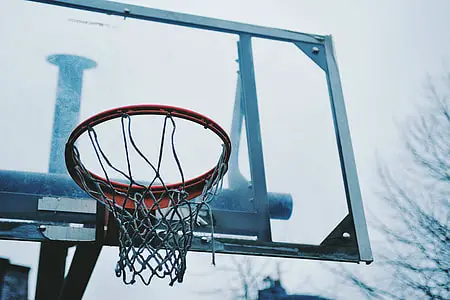
For every category, we’re going to list and explain the key things you should base your selection on and evaluate the pros and cons of each specific type of hoop so that you can make an informed decision on what type of basketball hoop is the best for filling your needs.
We should mention that there are some general characteristics or features that are important to consider with any type of basketball hoop.
We will be covering these over the course of the guide alongside the more type-specific characteristics and features for a more complete insight.
Once that foundation is set, we will give our top pick for each category based on research and personal experience.
Don’t worry, even if you don’t like our recommended product in your favorite category, you should leave with more than enough knowledge to make an informed choice on your own.
How To choose The best Portable Basketball Hoop
While it would be awesome to have a basketball court in your backyard, it is a fact of life that very few people actually have the space around their house for anything close to that. That means that many of us have to make the most out of the often limited space that we do have.
This is where portable hoops come in as they allow you to turn regular areas of your front or back yard into an improvised basketball court. The way these hoops are constructed allows you to relatively easily move them around, set them up where needed, and return them to storage when you’re done.
They are generally a great choice for people without the means or the space to set up a more permanent basketball hoop such as a mounted on an in-ground one. That is not to say that they can’t act as a part of a dedicated basketball court, but they’re not necessarily the best option in that case.
The two most important things specific to portable hoops you should consider when purchasing a portable hoop are the support pole and the base of the hoop. We will examine them in more detail in the following segment.
What To Look For
Let’s start with the defining feature of a portable basketball hoop, its base. The bases of these hoops are what keeps them upright and what allows them to be moved relatively easily from one place to another. How is this accomplished?
The base itself will almost never be a solid object. It will instead be designed to be weighed down with external weights, or more commonly, filled with sand or water. So, which of the two is likely the right choice for you?
I’ve seen portable hoops with external weights used mostly on outdoor tournaments. The word “portable” is being kind of stretched here as these hoops usually have large constructions that take up a lot of space and need a lot of external weight (easily more than 400 lbs.) to be properly stabilized.
The good thing about these hoops in my experience is that they do a great job of replicating the feel and the performance of an actual gym hoop. For an average user, however, they are simply too impractical because of their size, weight, and high price compared to the alternatives.
The bases that need to be filled can usually be filled with sand and/or water as we’ve mentioned already, but sand may provide better stabilization as it is around 75% heavier than water in the same volume. The bad thing about using sand is that it can be awkward to properly fill the whole base with it.
That is on top of mentioning that most people aren’t going to have a few hundred pounds of sand lying around their house. This brings us to using water, a much more accessible alternative. At the price of somewhat lower stabilization, water makes it much easier to fill the whole base quickly.
The instructions that should come with your hoop will tell you how much weight is needed to provide optimal stability, and that will help you decide which material to use. There should also be a way to quickly empty the base so you can move the hoop back into storage when you’re done.
One final note on base stability has to do with the shape of the base. A good rule of thumb is that the base should have a shape relatively close to a square when looked at from above. This balanced shape should prevent the hoop from being more susceptible to instability along one axis.
In order to make the moving process easier, many bases will feature at least a pair of wheels to make moving the hoop around easier, so it might be a good idea to find a base like that if you don’t want to spend more time moving the hoop than playing on it.
Let’s move onto the pole. Most poles should be made out of metal and be either round or square, but the truth is that the shape doesn’t really matter all that much in terms of performance. What matters more is the thickness of the pole.
A good rule of thumb is that thicker poles are generally going to be the more stable poles, but that doesn’t necessarily mean you should go for the thickest pole you find. More metal means more weight, and more weight means harder to move around, so try to find a good middle ground.
Whatever you do, do your best to avoid super thin poles as they will severely impact the stability of your hoop when the ball hits the rim or the backboard, and no amount of weight in the base will be able to compensate for it.
Stability is super important for portable hoops, but there are limits. While the tips in this segment will help you pick the most stable hoop, don’t expect gym hoop-level stability as you will never have it with portable ones. This is perfectly fine, and you will still get plenty of quality practice on your new hoop.
Some poles will allow you to easily adjust the height of the rim while others will have the rim on a fixed height. If you’re buying a hoop for your little kid, you might want to invest in an adjustable one so they can practice on a shorter hoop, and you can easily lift it to the regulation 10’ when the time comes.
Recommendation For You – Spalding NBA Hybrid with a 60’’ Backboard
The portable hoop I’m choosing to recommend is the Spalding Hybrid portable hoop with a 60’’ acrylic backboard (there is also a 54’’ version). The reason why I’ve decided to choose this particular hoop is simple, Spalding did nearly everything right when it comes to the design on the hoop.
For starters, it has a good, wide base, and the angle of the support pole offers some extra stability. The base is meant to be filled with sand in one part and water in the other, hence the “hybrid” in the name. There are two wheels in the front of the base for easier movement.
The 60’’ acrylic backboard will let you practice a wide range of layups and bank shots, while a good breakaway rim will provide realistic rebounding angles. The height of the rim can be adjusted from 7.5 to 10 feet with an easy-to-use lever in the back that can be removed to prevent any tampering.
There is some good offset behind the backboard that will give you some extra security when practicing layups or driving along the baseline, and the overall quality of the product is impressive for a portable hoop.
These are some of the main qualities that have drawn me to this particular hoop and if you’d like to hear a bit more about what it offers, I’d recommend this great video review which goes over some of the finer details and the feel of playing on this hoop.
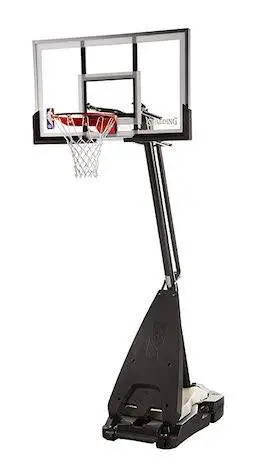
Spalding NBA Hybrid with a 60’’ Backboard
How To Choose The Best In Ground Basketball Hoop
Those of you with the space and the resources to make a dedicated basketball court in your yard might want to consider investing in an in-ground basketball hoop. As the name suggests, this hoop is designed to be permanently buried into the ground as a part of a court.
A few years ago I made several trips to Lithuania, probably the most basketball-loving nation in the world. The number of public courts in the cities in Vilnius and Kaunas didn’t surprise me, but the number of people who built courts in their yards was absolutely off the charts.
They went all out, not only with the hoops (most of which were high quality products), but with the surface of the court, the accurate lines on it, everything. Many professional 3×3 tournament organizers wouldn’t have been ashamed of hosting an official tournament on many of those courts.
Having your own dedicated basketball court is the ultimate way to practice, and it is no wonder why Lithuania has such a staggeringly high number of great players for such a small nation. Getting a good in-ground hoop is the first step toward building your own court, so let’s see how to pick a good one.
What To Look For
The defining feature of in-ground hoops is that they need to be built with a dug-in concrete base. This will require digging a hole the size of which will be outlined in the instructions that come with the hoop. The hole is not usually very large in terms of surface area, but it can easily be deeper than 40’’.
Some people like to dig a bit deeper and steel rebar is usually added to reinforce the concrete. The sheer volume of the hole needed for a base means that you should be ready to secure quite a bit of concrete before you start building your hoop, as many as 80 or 90 lbs. in some cases.
Before you even start digging, however, make sure that you won’t accidentally take out the cable for your entire neighborhood or damage some other utility line. You’d be surprised how many utility lines can run underneath your yard, and damaging one can be both very dangerous and very expensive.
The best way to avoid this is to check with the local utility companies if there are any lines running underneath your yard and how to avoid them. In some countries, there are also dedicated numbers you can call that can give you this kind of information for all types of utilities.
Once you’ve dug the hole and filled it with concrete, it is time to “plant” your hoop. This can be done in one of two ways – directly or via an anchor. I’ll now explain the differences but, spoiler alert, the anchor is by far the superior method.
Cheaper hoops are usually designed so that the support pole is inserted directly into the concrete. This means that you will have to insert the hoop perfectly on your first attempt if you want it to be perfectly upright and don’t want to end up with a tilted hoop, which is next to useless.
Even if you manage to insert the hoop into the concrete perfectly vertically, you will have to improvise a way to keep it in that position until the concrete hardens. This is not an easy task given that some hoops can weigh more than 300 lbs. which is a lot of weight to perfectly fix in place.
More expensive hoops usually feature an anchor that looks similar to this. The prongs on the bottom are supposed to be inserted into the concrete until the flat surface touches the concrete. The support pole is then fixed to the anchor via special bolts.
Even if you don’t insert the anchor perfectly parallel to the ground, you can still control the angle of the hoop by adjusting the nuts on the anchor bolts and end up with a perfectly vertical hoop. I definitely recommend getting a hoop with an anchor if you can spare a bit of extra cash.
Since the hoop is dug into the ground, it will be very stable, and accidentally hitting the support pole can be very painful or even dangerous. When buying your hoop, it would be prudent to ensure that the support pole comes with some protective padding and that there is enough offset.
Offset will be explained in more detail later on in the guide, but when it comes to padding, it is extremely important as you don’t want to accidentally run full speed into an exposed thick metal pole. If there isn’t any padding on the pole by default, you might want to buy some and add it on your own.
Recommendation For You – Ironclad Sports Game Changer GC55-LG
In-ground hoops can easily cost as much as $2.000 in some cases. With that in mind, I have chosen to recommend a hoop that strikes a great balance between what you get and what you pay for this category.
The model in question is Ironclad Sports’ Game Changer with a 60’’ backboard, and here’s why. Starting from the bottom, it has the kind of anchoring system that I already wrote about in the previous segment. The support pole is wide and it comes with a lot of padding for great security.
The height of the rim can be easily adjusted from 7.5’ to 10’ via a crank in the back of the pole. What I like the most about this hoop are the backboard and the rim. The backboard is made out of tempered glass, which is the material you will see in professional-level hoops.
There is also padding along the edges of the backboard, and that padding is one of those things you never knew you needed until you actually need it as it can protect your hands from injury if you hit the sharp edges of the backboard.
The breakaway rim is bolted directly onto the support pole for added security and it will endure dunking without any problems. The manufacturer is so sure of this that they often a lifetime warranty which includes dunking and hanging.
Overall, the hoop is probably a great choice for you is you’re looking for a versatile and durable hoop, and you are ready to pay for quality but don’t want to absolutely break the bank. If you’d like to see the hoop up close and in great detail, here is a great video that will let you do just that.
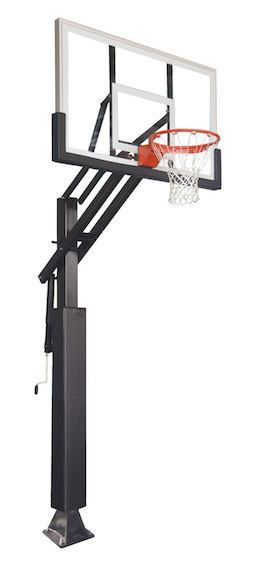
Ironclad Sports Game Changer GC55-LG
How To Choose The Best Wall Mounted Basketball Hoop
Wall-mounted hoops aren’t going to have any kind of support pole or base because they are designed to use a wall as their base. This makes them very stable, and a great option for those who can’t set up an in-ground hoop and don’t find portable hoops practical.
You should keep in mind that this design can make them somewhat limited in terms of what you can do with them. Shooting practice will go just fine with these hoops, but playing games or practicing aggressive layups can be made difficult or even dangerous by the wall behind the backboard.
With portable and in-ground hoops, the support pole and/or the base can generally be easily avoided when going for a layup or driving underneath it, but with wall-mounted hoops, a single relatively thin pole is replaced with a wide wall that is impossible to avoid.
If shooting or regular layups are the only things you want to practice, then even a cheap mounted hoop might be just what you need. But if you want to do more than that and still insist on getting a wall-mounted hoop, there are options out there, but they will cost you.
What To Look For
We have already briefly touched on the issue of the space behind the backboard and what awaits you there. Cheaper hoops usually won’t have much space, while the more expensive ones will often have several feet of space for added versatility. With that being said, let’s move onto the specifics.
The first thing you need to decide when going for a wall-mounted hoop is where you’re going to place it. You will need a sturdy wall that will support the weight of the hoop and that you don’t have a problem with drilling into.
Lighter hoops will often be designed so that the backboard holders are bolted directly to the wall, while the heavier ones will often have an anchoring frame that is bolted onto the wall to help support the weight of the backboard.
One important note in terms of placement is to make sure that there isn’t any kind of roof or balcony that extends immediately above the edge of the backboard as this will make the hoop awkward to use and might damage your ball if it hits the edge of whatever is extending over the backboard.
Setting your hoop at the right height is incredibly important. An improperly installed hoop can destroy your experience of playing on it, so make sure to pay great attention to the instructions that come with the hoop.
Some hoops come with anchor railings that allow you to make slight adjustments up or down in order to compensate for imperfect installation, but it’s best to just get it right the first time. If you don’t want to take risks and can spare some extra cash, it might be a good idea to pay for professional installation.
There isn’t really that much else to speak of that is specific to wall-mounted hoops, and the broader general concepts will be covered in the segments on the best indoor and outdoor hoops. I suggest you pay special attention to offset, one of the said concepts and the Achilles’ heel of many mounted hoops.
All things considered, wall-mounted hoops usually offer great stability and they can be a great option for users willing to embrace their inherent limitations. If practicing shooting is your main concern, then a wall-mounted hoop might be the best option for you.
Recommendation For You – Goalsetter Adjustable Glass Backboard
The specific hoop I have chosen to recommend for this category is the Goalsetter GS72 Wall Mounted Adjustable basketball hoop. In my opinion, it makes the best of the characteristics of the wall-mounted design and does a decent job of addressing some of its shortcomings.
The defining feature of this hoop is the regulation size (72’’) tempered glass backboard that works with an enclosed breakaway rim to offer performance similar to that of actual gym hoops. The downside of a 72’’ tempered glass backboard is that it is quite heavy, so you’ll need a sturdy wall to mount it.
This kind of setup means that you’ll be able to have very realistic shooting practices on this hoop, but it is more than a mere shooting goal. In the previous segment, I mentioned that the problem of not having enough space behind the backboard plagues many wall-mounted hoops.
This hoop does a decent job of mitigating that issue as it has almost 3’ of space between the backboard and the wall. This is probably enough for most people to play regular games on or practice fancy layups without fearing that they will hit a wall.
Some other noteworthy features include rim height adjustment between 6’ and 10’ so that kids or younger siblings can use the hoop easier and an anchor mounting system for easier installation onto a wall.
Overall, this hoop is probably the right choice for you if you’re someone who wants a wall-mounted hoop they can play or practice a variety of things on and that can offer near gym-like performance, but don’t mind the extra weight or the cost of a regulation-sized tempered glass backboard.
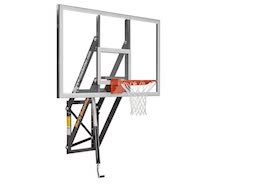
Goalsetter Adjustable Glass Backboard
How To Choose the Best Outdoor Basketball Hoop
Out of the three types of hoops covered so far, all three are primarily designed or viable for for outdoor use, although you will see high-end portable or wall-mounted hoops in gyms as well. I’ve played official games on both types of hoops, so they are definitely viable for competitive play.
So far, we have covered some features and characteristics unique to the individual type of hoops, so I’d like to use this segment to explain some concepts that are universally important for all outdoor hoops, as well as some general things you need to consider when buying a basketball hoop of any kind.
What To Look For
Any outdoor piece of hardware will unavoidably be exposed to the influences of the elements sooner or later, basketball hoops included. Whether it is rain that can lead to corrosion or sunlight that can cause the paint or the decals to fade, the elements can take a heavy toll on your hoop.
So how do we prevent this? Since rust is a structural problem that could end up rendering your hoop unusable, we’ll start with that one. Many hoops will tout some kind of anti-rust protection in terms of various coatings on their metal surfaces i.e. most of the hoop’s actual parts.
These can range from special paints to special metal coatings or alloys that don’t rust. I definitely recommend getting a hoop with such protective measures, but if that is not an option, it might be a good idea to purchase anti-rust coating yourself and apply it to your hoop as it will prolong its life.
UV radiation which is present in sunlight can cause cosmetic problems in terms of your decals fading away or components changing color. Some hoops will feature protective measures against this as well, but they are not as important as anti-rust protection since you can easily reapply the decals yourself.
One more important thing to note regarding exposure to elements is the type of net present on your hoop. The two main types are nylon nets and chain nets. Nylon nets are the ones found in professional hoops and they make the incredibly satisfying “swish” sound when you sink a shot.
Chain nets are more often found on streetball hoops and they do a great job of not letting your ball go far when you hit a shot. However, the metal chain links can damage your ball, especially if you’re using a higher-end leather ball.
Heavier nylon nets can withstand the wrath of the elements for many years in my experience, while rust can become a problem for chain ones. Whatever you do, avoid the thin nylon nets that come with some cheaper hoops because you are lucky if they last a month in some cases.
My sincere recommendation is that you invest in a heavier nylon net because that kind of net will easily last several years. We put one such net up on our local public hoop four years ago and it still serves us well to this very day.
One final thing I want to cover is the shape of the backboard. You will find two main options – fan-shaped backboards and rectangular backboards.
Fan-shaped backboards are usually associated with streetball courts in the US. In terms of functionality, they will limit your ability to practice bank shots or fancy layups, so they’re probably not a good idea for you if you want to practice a wide variety of moves and shots on your hoop.
They will often be made out of lower-quality materials, such as plastic or plywood, and I have yet to encounter one made from high-end materials like tempered glass. This makes them the cheaper of the two alternatives.
Rectangular backboards are used on professional hoops and they will, depending on the size, allow you to practice virtually any kind of shot or move under the sun. In consumer-grade hoops, they can vary in size from 40’’ all the way up to the regulation 72’’.
If you want to have the most realistic experience, I recommend either the 60’’ or the 72’’ versions as they won’t limit your practice as the smaller backboards would. They can be made from low-end or high-end materials, so they will in most cases be the more expensive of the two alternatives.
Recommendation For You – Pro Dunk Platinum 72 Inch Glass Backboard
The recommended hoop for this category is the Pro Dunk Platinum with the 72’’ tempered glass backboard. In the eyes of many people, myself included, this is the best outdoor hoop on the market, and it’s not difficult to see why.
The anchoring system and a massive support pole offer great stability, and the abundant padding on the pole provides good protection. All of the metal components on the hoop have several layers of rust protection to ensure longevity.
We’ve already talked about the benefits of a full-sized tempered glass backboard and a breakaway rim, so we won’t repeat ourselves here. What should be mentioned, however, is that the rim can be lowered to a record height of 5.5’.
If you’re looking for the absolute top of the line product that will last you for many years and that comes as close as possible to the performance of gym hoops, this is probably the product for you.
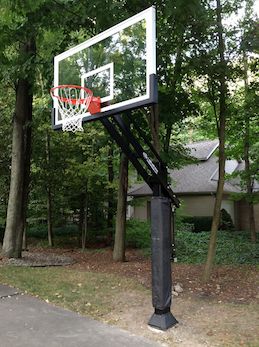
Pro Dunk Platinum 72 Inch Glass Backboard
How To Choose the Best Indoor Basketball Hoop
Indoor hoops you find will come in one of three main variants – portable, wall-mounted, or ceiling-suspended. The word “portable” is used very loosely here since “portable” gym hoops will easily weigh more than 1.000 lbs.
Just like with the previous segment, I’d like to use this one to explain some concepts that are universally important for all indoor hoops, as well as some general things you need to consider when buying a basketball hoop of any kind.
What To Look For
Any hoop will have one of two types of rims – fixed or breakaway. As the name suggests, fixed rims are bolted onto the backboard or the support pole without any way to absorb the force of a dunk, which can lead to them easily breaking upon being dunked on.
Breakaway rims solve this problem with a “joint” and one or two springs that let the hoop better absorb such forces. When you see dunks in professional games, the rim will often “break” to a degree and snap back into position when the player releases it.
If you want a rim that can absorb the force of a dunk and provide the most realistic performance, go for a breakaway one. If these things are not important to you, then going for a fixed rim will satisfy your needs just fine and save you some cash in the process.
We have previously mentioned the importance of backboard materials. Now we will go into a bit more detail on the topic and help you decide which of the three options is the best fit for your needs and your budget.
Plastic is at the bottom of the backboard material totem pole as the quality of plastic backboards is generally poor and they don’t provide even remotely realistic performance. Acrylic is the middle-of-the-road backboard material with satisfactory performance.
I play pickup games two times a week in a gym with acrylic backboards and I am quite happy with their performance save for a few rare cases where I was surprised by the way the ball interacted with the backboard. Overall, they should be more than adequate for the average user.
Finally, we have the tempered glass backboard. That is the material used in professional hoops and it offers the best performance out of the three materials. If you want the most realistic performance out of your backboard for layups and bank shots, tempered glass is the right material for you.
One last consideration related to backboards is the offset. Simply put, it is the amount of space between the backboard and the support pole, and it is incredibly important when it comes to injury prevention. The lower the offset, the higher the chance of a player hitting the support pole or wall.
Professional hoops have a great amount of offset (up to almost 11’), whereas you’re lucky to get 3’ of offset with the consumer-grade hoops. A lack of offset has caused serious injuries even to professional players, so I sincerely hope that you will pay attention to offset when purchasing your new hoop.
Recommendation For You – Glass Spalding Arena
For this category, I have chosen to recommend a top of the line hoop that is fit for professional play. The model in question is Spalding’s Arena Portable Backstop. You’ll notice right away that the hoop looks quite similar to the hoops used in NBA or Euroleague games.
The performance is what you would expect from such a hoop, it features an enclosed breakaway rim and a regulation-sized tempered glass backboard. The padding on the base and the support pole and the backboard edges is superb, while nearly 11’ of offset means that it offers a high level of security.
There are a few extra features to make it easier to operate, such as a spring-assisted lifting mechanism. For official games, there is also a shot clock holder that can be bought separately. The hoop is fit for all levels of official play as it can be locked in at either 8’, 9’, or 10’.
It is a very heavy and very expensive piece of equipment, but if you’re someone looking to outfit their gym with high-quality equipment fit for official play, then this hoop is probably a good choice for you.
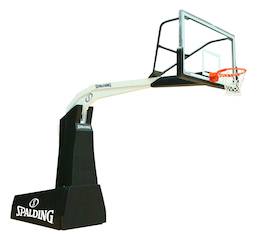
How To Choose The Best Pool Basketball Hoop
You may have seen at least one of those awesome pool dunk videos on YouTube or Facebook/Instagram because more than a few of them went viral over the last couple of years. If you don’t know what I’m talking about, here is a great example. Looks pretty fun, right?
While attempting to recreate complex pool dunks like this is probably too dangerous to try at home, playing “basketball” in the pool is still an incredibly fun twist on the game and it is definitely worth a try if you ever get the chance.
I first got this opportunity two years ago when I was on a beach that had a floating hoop. The sea wasn’t calm and the waves were throwing the hoop all over the place so it wasn’t easy to hit a shot, but we had a blast regardless. For those of you with a pool, here’s how to find the best pool hoop.
What To Look For
Pool hoops come in two main variants – those that float and those set on the edge of the pool. Floating hoops can be placed anywhere on the surface of the pool and some can be fixed to the bottom with a rope. They allow for a 360-degree field of play around the hoop which allows for more players.
Two main problems with these hoops are the lack of a backboard and the fact that they can tip over very easily in some cases which means that you’ll have to stop the game to fix the hoop. Hoops that go on the edge of the pool are for all intents and purposes scaled-down versions of portable hoops.
They are made from lower-quality materials than regular portable hoops, usually plastic and aluminum, but that’s perfectly fine for hoops designed for fun rather than serious play. These hoops have backboards and some have an adjustable rim, just don’t expect a breakaway rim as well.
The backboard makes it somewhat easier to score on than the floating hoop, but their positioning means that you won’t have a 360-degree field of play to work with. There isn’t a strictly better of the two alternatives and it all comes down to your preference.
One more thing to keep in mind is that if your hoop has any metal parts, corrosion is going to become an issue sooner or later because of the treated pool water, even if the metal has anti-rust coatings. This means that you need to buy and periodically apply anti-rust protection on your own.
Recommendation For You – Dunnrite Splash Swimming Pool Hoop
My recommendation for this category is the Dunnrite Splash and Shoot Swimming Pool Basketball Hoop. It is a portable hoop that is placed on the edge of the pool and the base is filled with water or sand. The base has no wheels, but the hoop is small and light enough to not need wheels.
A plastic fan-shaped backboard will make scoring a bit easier and a steel rim will withstand dunking, although you shouldn’t hang on it or the entire hoop will tip over. You can adjust the height of the rim to fit the depth of your pool and make scoring more or less challenging if you want to.
There is a protective coating on the metal parts of the hoop, but don’t expect it to last indefinitely. My sincerest advice if you decide to go for this is to buy some kind of anti-rust spray or coating and apply it regularly.
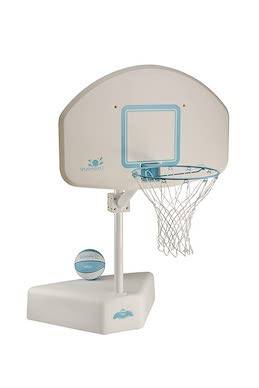
Dunnrite Splash Swimming Pool Hoop
How To Choose The Best Trampoline Basketball Hoop
I used to love trampolines when I was a kid. By the time I found out that there are trampolines with basketball hoops attached, I was way past the load limitations of 99% of trampolines. Not only are there trampolines with hoops, but there is also an entire sport that revolves around the concept.
Obviously, the full-contact nature of that spot is not suitable for children, but trampoline hoops can be an amazing source of entertainment for anyone. Obviously, they’re not meant for serious practice and they won’t make you a better shooter, but you can get a lifetime worth of dunks in a single session.
What To Look For
With trampolines being an integral component, a few safety considerations should be made. Most trampolines use springs which are the source of a majority of trampoline-related injuries. There are alternatives that use special composite materials to create bounce if you want to avoid using springs.
The jumping surface of the trampoline is usually surrounded by a padded, yet harder, material which acts as a walking surface. You want to ensure that the padding on this surface is sufficient to absorb the impact of landing on it straight after bouncing.
Different trampolines will have different safety limitations which will most often be stated in terms of weight limitations. There shouldn’t be any problems regarding the number of kids that are using the trampoline at the same time as long as their combined weight doesn’t exceed the stated limit.
Any half-decent trampoline hoops will have a safety net around the trampoline that should be at least as high as the rim. This net can be held in place with a metal pole or other, softer materials. Softer materials make it harder to get injured as a result of hitting a pole, but metal is tougher.
Finally, you have the backboard. The backboard can be either solid (usually plastic) and held in place with a metal pole, or it can be flexible and hung on the safety net. The solid ones offer better durability when dunking, but the flexible ones make it harder to get hurt if you hit the backboard.
As you can see, there are many considerations and there are no setups that are strictly better or worse than any other setup because they all have different trade-offs and serve different niches. It’s up to you to use this information to determine what is the best setup for your needs.
Recommendation For You – Springfree Trampoline
I have chosen to emphasize the safety aspect of trampoline hoops with a recommendation for the Springfree Trampoline Basketball Hoop. This trampoline has a number of safety features that make it the safest trampoline hoop on the market.
For starters, the springs are replaced with flexible composite rods located below the jumping surface which protects the users from accidentally hitting them and provides the same level of bounce. There are also no hard edges near the jumping surface which offers further protection from injuries.
Keeping in line with the safety theme, the backboard is flexible and it is attached to the safety net itself without using any metal or other solid poles. The bottom metal frame of the trampoline offers great rust protection and many users have reported that the trampoline is extremely durable.
If you’re thinking of buying a trampoline hoop for your yard and safety is your primary concern, this is probably the right product for you. With a generous load limit of 220 lbs., you’ll likely be able to try it out for yourself and get in on the fun.
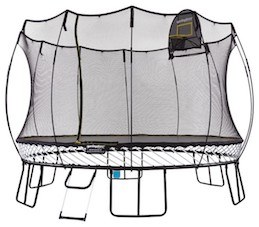
How To choose the Best Portable Basketball Hoop For a Driveway
We have already dedicated a section of this guide specifically to choosing a portable basketball hoop. Many people are going to be using their hoop in their driveway as it is the likeliest place anyone will have a concrete surface in their yard.
With that in mind, we have decided to revisit the topic of portable hoops with a tighter focus on choosing a hoop specifically for use in a driveway. The following segment will aim to expand a bit on the already familiar concepts important for choosing a portable hoop.
What To Look For
When picking your new portable hoop to use in a driveway, the name of the game is mobility. You need to be able to move the hoop out of the way quickly if there is a car coming in to park. This means that you need to pay special attention to the base and the overall weight of the hoop.
Two things should be considered regarding the base. The first are the already mentioned wheels as they make moving the hoop around a LOT easier. The wheels are usually located in the front or in the rear of the base, and the front ones are a better option in my opinion.
The second thing regarding the base is how easy is it to eject the filling from the base, whether it is water or sand. There shouldn’t be problems if you’re using sandbags. If you’re using water, then you should look for a base with a plug that can let the water out without having to tilt the base.
The overall weight of the hoop also plays a role, the ticker the support pole and the larger your backboard, the heavier and less mobile your hoop will be. Sure, you want a stable hoop but you need it to be mobile as well, and sacrificing a bit of stability is an acceptable trade-off here.
You should also note that plastic and acrylic backboards are generally lighter than tempered glass ones. Finally, it would be ideal if you could find a hoop that lets you adjust the angle of the support pole if your driveway is not a flat surface, but this will be very difficult to find in most cases.
Recommendation For You – Spalding NBA Hybrid with a 60’’ Backboard
The recommended product for this category is still the Spalding Hybrid Portable as I still feel it is one of the best portable hoops around, but there is one difference for this category. To reduce the weight, I suggest you go with the 54’’ acrylic backboard version instead of a 60’’ one.
When it comes to filling the base, I suggest using four 50-pound sandbags without any water as they should provide enough stability for playing, and you can quickly take them out once you need to move the hoop.
There are front-mounted wheels on the base of the hoop, so the 54’’ acrylic backboard version of this hoop checks pretty much all the major boxes when it comes to mobility and driveway use.

Spalding NBA Hybrid with a 60’’ Backboard
How To choose The Best Adjustable basketball hoop
So far, we have mentioned the ability to adjust the height of the rim as a desirable feature of someone the hoops that were listed as the recommended products for their category. Having an adjustable hoop is necessary if you are buying it with the expectation that children will be practicing or playing on it.
Not all games are played on 10’ hoops, the smallest youth categories play on hoops as low as 6’. As such, it makes no sense to force kids to use 10’ hoops before they are physically ready to do so. Besides, having an adjustable hoop lets people who aren’t naturally tall or athletic enough throw down a dunk.
As you can see, getting an adjustable hoop makes sense for multiple reasons and we are going to dedicate the following segment to the most important things you need to know regarding adjustable hoops.
What To Look For
For starters, all kinds of hoops can be adjustable, whether they are portable, wall-mounted or in-ground. This height adjustment can be done in two main ways. The first is to physically bolt the backboard lower or higher on the support pole. This method is used only on very cheap hoops.
Even mid-range hoops will use some sort of crank or lever mechanism to facilitate the height adjustment. The adjustments may be done in fixed increments or freely. The most advanced hoops will be able to automatically lock in certain rim heights, but this is reserved mostly for pro-level hoops.
Most consumer-grade hoops will use a crank or a lever, both of which are perfectly viable systems and they are used on some of the hoops recommended in this guide. Depending on the quality of the construction of these mechanisms, the stability of the hoop may be impacted.
In my experience, crank-based mechanisms are somewhat superior to the lever-based ones because they let you adjust the height at will instead of in fixed increments and they are sturdier, thus having a smaller impact on the stability of the hoop.
Recommendation For You – Ironclad Sports Game Changer GC55-LG
I will stick to my recommendation for the best in-ground hoop as the best overall adjustable hoop as well. The model in question was Ironclad Sports’ Game Changer with a 60’’ backboard. It features a crank-based height adjustment system.
This crank lets you adjust the height of the rim to anywhere between 7.5’ and 10’ in any kind of increments you wish. I have previously talked about the hoop’s features and I’d just like to reemphasize its high durability and great value for money as the two main factors that led me to pick it again.

Ironclad Sports Game Changer GC55-LG
How to choose the best portable basketball hoop under $300
Up to this point, most of the recommended serious hoops have been in the mid to high price range. While it is inevitable that quality comes at a price, I certainly understand the need for budget options and it would only be fair that we touch on the subject of budget portable hoops.
Compared to our previous recommendations, picking out a budget hoop is a question of what you’re willing to sacrifice to make it fit into your budget. I’ll do my best to explain how to get under your budget with the least possible sacrifice.
What To Look For
Before you start deciding what to sacrifice, you should first know what are the main requirements you have from a hoop.
Probably the easiest decision to make is whether or not you need an adjustable hoop. If you’re the only person who will be using the hoop, getting a hoop with the rim fixed at 10’ is probably a good way to save some money.
There are two main considerations to make when it comes to the backboard – the size and the material. The smaller the backboard, the cheaper it should be. 60’’ backboards will still allow for a variety of layups and bank shots, and I would avoid going under 54’’ if at all possible.
I would only recommend going for a smaller backboard if you want to practice nothing but pure shooting. In terms of materials, I am not at all a fan of polycarbonate, but it is the cheapest option. Acrylic is usually a good mix of price and performance, so I recommend it for budget purposes.
If you only want a hoop for pure shooting, you might as well go for maximum savings with polycarbonate. You should also expect the base and the support pole of budget hoops to be on the smaller side which could lead to somewhat decreased stability.
It is entirely possible to find budget hoops with breakaway rims but I wouldn’t count on those rims enduring any hanging or powerful dunks. Still, they are a good option for the more realistic rebounding they offer compared to fixed rims.
Last but not least are the material protections against rust and UV radiation. Don’t expect them to be great; it is always a good idea to buy some protective coatings and apply them yourself from time to time if you want to give your hoop the best possible protection.
Recommendation For You – Spalding NBA 54″ Acrylic
I was positively surprised by the features of some of the budget options, especially the model I chose to recommend for this category – The Spalding Pro Slam Portable.
It features a 54’’ acrylic backboard (there are variants with a polycarbonate backboard too) that should be just big enough to practice all but the most advanced layups and bank shots. Acrylic will offer good interaction with the ball and close to realistic rebounding performance.
The rim featured on the hoop is a breakaway one, although it is a lower-end breakaway rim that I don’t recommend forcefully dunking on, let alone hanging on. Still, it should do just fine when it comes to rebounding performance.
The base and the support pole are not big, but they offer acceptable stability for their size. The height of the rim can even be adjusted with a mechanism at the back of the pole. Overall, I am very impressed with the hoop given that it can be picked up for just a bit over $200.
If you’re looking for a budget hoop but don’t want to make major sacrifices in any of the aforementioned segments, this is probably a good option for you.
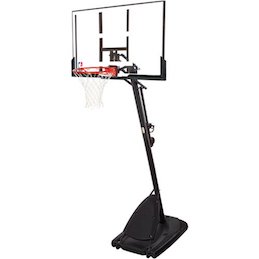
How to choose the best toddler basketball hoop
Every once in a while, a young prodigy comes along in a sport and blows everyone away with their level of skill, such as Luka Dončić is doing that in the NBA right now. When we talk about young prodigies, they don’t get much younger than trick shot Titus.
You may remember Titus from the viral videos (like this one) or TV shows where he showed off his shooting skills. Toy hoops can be a great source of entertainment for toddlers and they may even spark a love for the game basketball that stays with them for the rest of their lives.
A small toy hoop attached to one of the doors in my apartment with suction cups is one of the toys I have the fondest memories of from the time when I was a little kid, and I still have that hoop somewhere in my room, although I haven’t used it in nearly two decades.
What To Look For
With hoops for toddlers, you want to make sure that there are no small parts that might be a choking hazard and that the hoop itself is as light as possible without any sharp edges so that they don’t get hurt if the hoop falls on this.
Most decent hoops for toddlers will be made of light plastic with curved edges, so finding a safe hoop should be relatively easy. The two main types of hoops for toddlers are portable ones and mounted ones.
The former ones have bases that usually aren’t supposed to be filled with anything (but the option is still there) because the hoops are very light and not meant for dunking, while the latter ones are meant to be attached to a door via either sticky pads, hooks, or suction cups.
Some portable hoops are adjustable in height so you can increase the height of the rim as your child grows. I definitely recommend getting a hoop like this if possible simply because the hoop will able to “follow” the growth of your child.
The rims on these hoops are usually oversized to make scoring easier and you may or may not get a ball with your hoop. Some of these balls are a bit heavier or harder, so make sure there isn’t anything easily breakable behind the hoop.
Recommendation For You – Little Tikes Easy Score Basketball Set
I definitely recommend portable hoops over mounted ones, and my recommendation for this category reflects that. The model in question is the Little Tikes Easy Score Basketball Set that comes with three balls.
It is made entirely out of light plastic and it has a base that can be filled with sand for added stability, but it can be used perfectly well without the added weight. The height of the rim can be adjusted between 2.5’ and 4’.
An oversized rim makes it easier to score baskets and a net ensures that the balls won’t go too far from the hoop. Overall, it is a very good hoop and great help in developing your toddler’s motor skills.
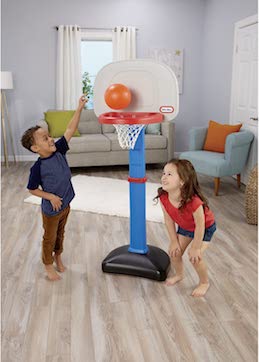
Little Tikes Easy Score Basketball Set
How to choose the best kids basketball hoop
Basketball hoops for kids are in many cases similar to hoops for toddlers, they are simply scaled up in size and constructed in a more solid matter. They represent a good bridge between hoops meant for entertainment and hoops meant for serious play.
Some of the hoops in this category may lean more towards one side or the other, but there are very good options available out there whatever your preference may be.
What To Look For
Since there are many similarities between hoops for toddlers and kids, we won’t be repeating the concepts that are the same. We will just list them and try to focus on the few differences between the hoops for the two age groups.
Just as with hoops for toddlers, there are portable and mounted options. Since some of the kids are already getting their first tastes of “serious” basketball, I recommend that you pick a hoop that is as close as possible to what they will be playing or practicing on.
Some of the major differences between the hoops for toddlers and kids are the materials and the bases of portable hoops. The hoops for toddlers are made almost exclusively from plastic, but hoops for older kids may contain metal parts.
In these cases, it is advisable to fill the base of the hoop with sand or water to make it more difficult for the hoop to tip over and injure the child or break something in the house. It is highly recommended that you get a hoop with an adjustable rim height for the same reason as with the hoops for toddlers.
Some hoops for kids will not need special balls and they will be designed to work with regular smaller basketballs that are used in youth games. This should be accounted for if you’re placing the hoop indoors because these balls can easily break something.
Recommendation For You – Lifetime 32 Youth Portable Basketball Hoop
My recommended hoop for this category will be a great successor to the hoop recommended for toddlers. The model in question is the Lifetime 32’’ Youth Portable Basketball Hoop.
The 10-gallon base should be filled with either sand or water to provide stability because the hoop features mostly metal parts. The support pole and the rim are both made out of metal resistant to rust and the weather, making this a good hoop for indoor or outdoor use.
The rim height can be adjusted between 5.5’ and 7.5’ in 6’’ increments, and a 32’’ plastic backboard will allow your kids to start learning and practicing layups and bank shots. It is a good idea to use an official miniature basketball (size 4 or 5) with this hoop because of its design and metal parts.
It is not very pricey and it will make for a great first “serious” hoop your kid will have. Many full-size hoops can be lowered to 7’ which means that this specific hoop will make a great bridge between toy hoops and the real thing.
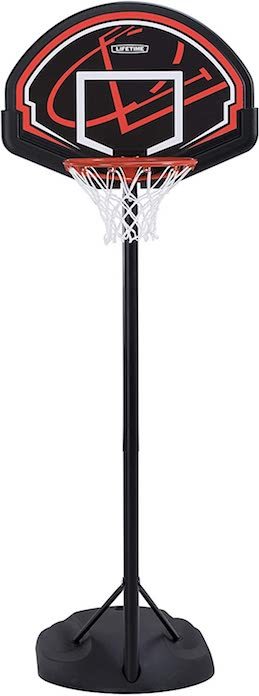
Lifetime 32 Youth Portable Basketball Hoop
Conclusion
Congratulations, you’ve reached the final chapter of this guide. We have covered virtually every type of hoop under the sun, both the serious ones and the not so serious ones, but all of them enable us to play the game we love in some way or another.
I sincerely hope that this guide has answered all the major questions you may have had about the factors you need to consider when buying a basketball hoop and that you have learned how to select the best basketball hoop for you.
In the future, there are probably going to be more detailed guides and reviews on specific types or models of basketball hoops, so this is definitely not the last time that we will visit the topic of hoops.
If you have a suggestion for a specific topic that I should cover, let me know in the comments below.
In the meantime, I hope that you will get plenty of fun and quality practice out of your new hoops and that they will serve you well for many years to come.
What was your favorite hoop on our list?
Did you happen to play on one of our recommended hoops or did you decide to give one of them a chance?
Please let me know in the comments, I’m always interested to hear the experiences of the readers.
That would be all for this guide. Until next time, happy holidays and happy hooping!

